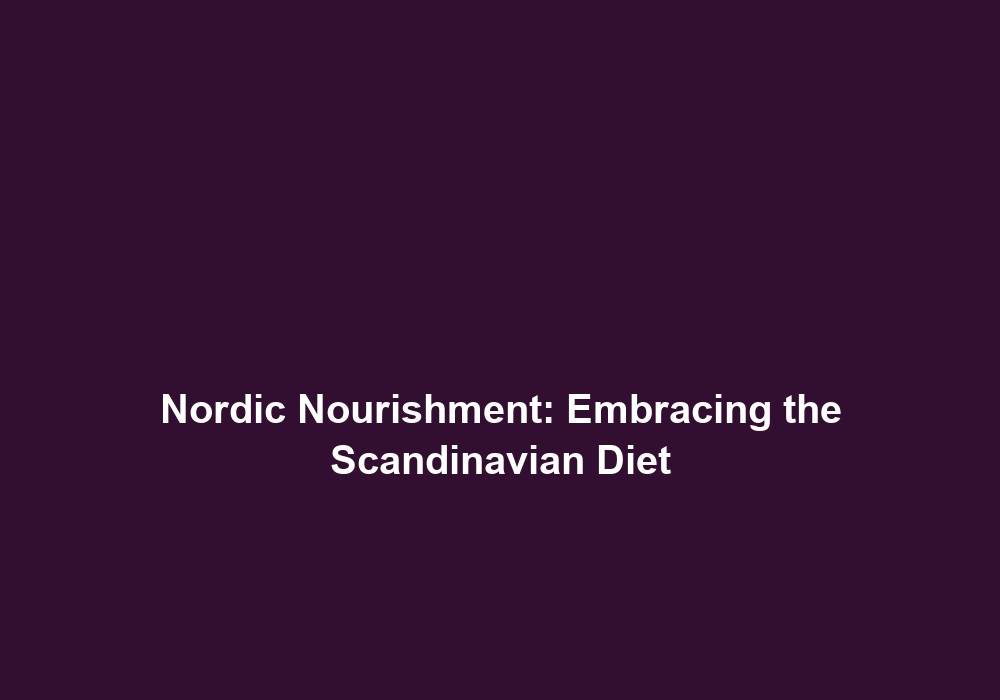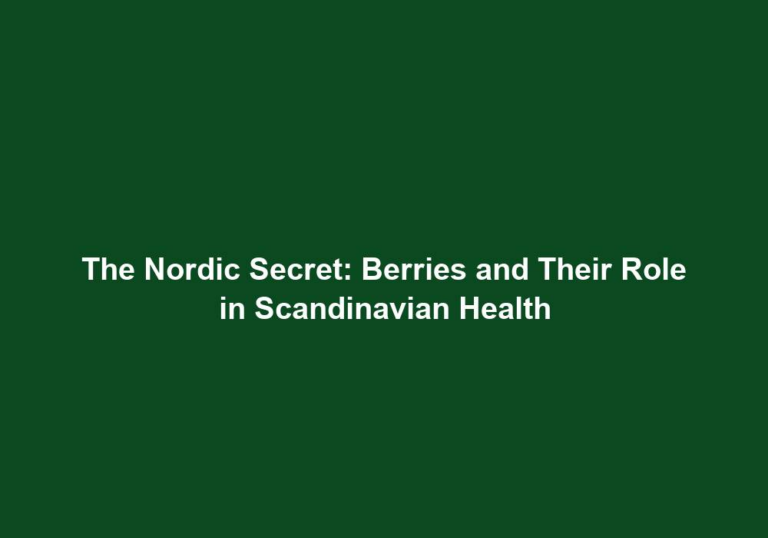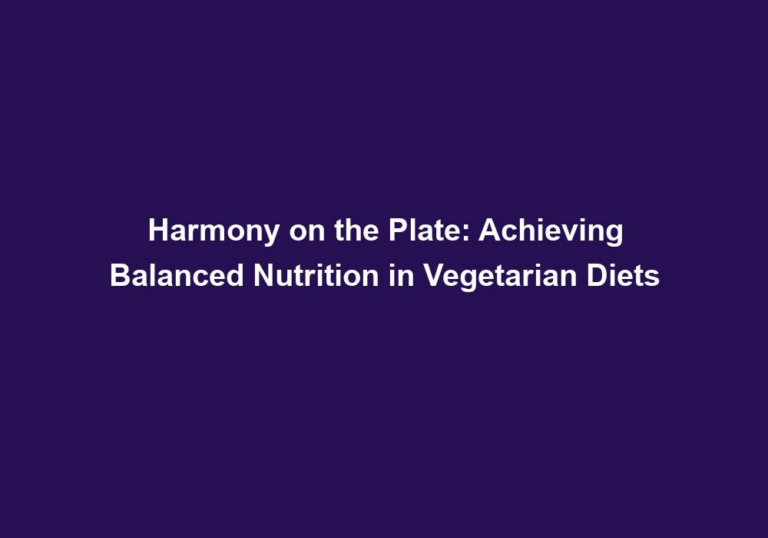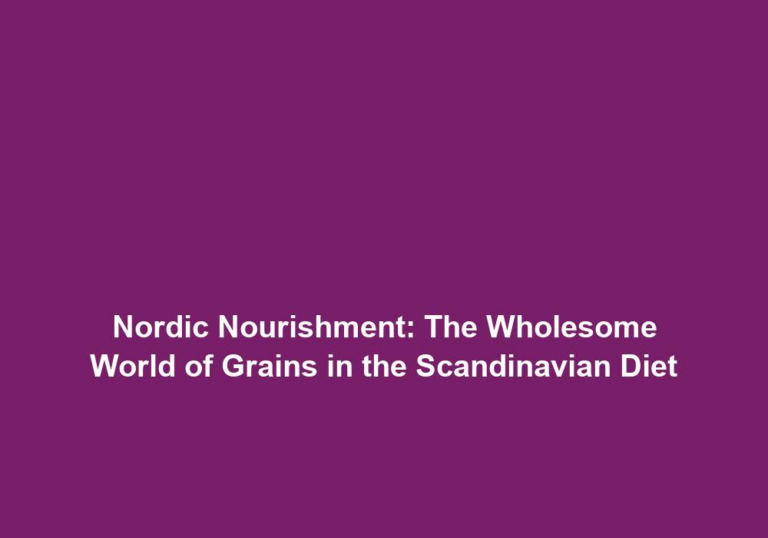Nordic Nourishment: Embracing the Scandinavian Diet
The Scandinavian diet, also known as the Nordic diet, has gained popularity in recent years for its numerous health benefits and emphasis on fresh, whole foods. This eating pattern is inspired by the traditional diets of countries like Sweden, Norway, Denmark, Finland, and Iceland. Rich in fruits, vegetables, whole grains, fatty fish, and lean meats, the Scandinavian diet is not only delicious but also promotes overall well-being and longevity. In this article, we will delve into the key aspects of the Nordic diet and explore its potential impact on our health.
What Makes the Scandinavian Diet Unique?
The Scandinavian diet is often hailed as one of the healthiest diets in the world due to its focus on nutrient-dense, unprocessed foods. It shares similarities with other Mediterranean-style diets, but with its own unique twist. Here are some key characteristics of the Scandinavian diet:
1. Abundance of Fruits and Vegetables
The Nordic diet places a strong emphasis on the consumption of fruits and vegetables. These colorful powerhouses are rich in essential vitamins, minerals, and antioxidants, which play a crucial role in protecting our bodies against various diseases. In fact, the Nordic countries boast a wide variety of seasonal fruits and vegetables, from berries and root vegetables to leafy greens and wild mushrooms.
Eating a variety of fruits and vegetables provides a range of nutrients that support overall health. The high fiber content in these foods aids digestion, promotes feelings of fullness, and helps maintain stable blood sugar levels. Additionally, the antioxidants found in fruits and vegetables help fight inflammation and reduce the risk of chronic diseases such as heart disease and certain types of cancer.
2. Incorporation of Whole Grains
Whole grains, such as oats, rye, barley, and quinoa, are an integral part of the Scandinavian diet. They provide a good source of dietary fiber, which aids digestion, promotes satiety, and helps maintain stable blood sugar levels. Whole grains also contain important nutrients like B vitamins, iron, and magnesium, contributing to overall health and well-being.
Incorporating whole grains into your diet can help reduce the risk of developing chronic conditions such as heart disease, type 2 diabetes, and obesity. The fiber in whole grains slows down digestion, preventing rapid spikes in blood sugar levels. This steady release of energy helps you feel fuller for longer and can aid in weight management.
3. Focus on Fatty Fish
The Nordic region is surrounded by the Atlantic and Arctic Oceans, making fatty fish like salmon, herring, mackerel, and trout easily accessible. These fish are rich in omega-3 fatty acids, which are essential for heart and brain health. Omega-3s have been linked to a reduced risk of cardiovascular disease, improved cognitive function, and decreased inflammation.
Including fatty fish in your diet provides a significant source of omega-3 fatty acids, which offer numerous health benefits. Omega-3s help lower triglyceride levels, reduce blood pressure, and decrease the risk of blood clot formation. These fatty acids also support brain health and may help improve mood, reduce symptoms of depression, and enhance cognitive function.
4. Inclusion of Lean Meats and Dairy Products
While the Scandinavian diet primarily emphasizes plant-based foods, lean meats and dairy products are also included in moderation. High-quality sources of protein, such as poultry, lean cuts of meat, and low-fat dairy, provide essential amino acids, vitamins, and minerals necessary for muscle growth, cell repair, and overall immune function.
Lean meats and dairy products are excellent sources of protein, which is essential for the growth, repair, and maintenance of body tissues. Protein also helps regulate appetite and contributes to a feeling of fullness after meals. Including lean meats and dairy in the diet ensures an adequate intake of important nutrients like vitamin B12, calcium, and zinc.
5. Embracing Local and Seasonal Ingredients
The Scandinavian diet places great importance on consuming local and seasonal ingredients. This not only ensures fresher and more flavorful foods but also supports local farmers and reduces the environmental impact of transportation. By prioritizing local and seasonal produce, the Nordic diet promotes sustainability and a deeper connection with nature.
Choosing local and seasonal ingredients has several benefits. Firstly, these foods are harvested at their peak ripeness, meaning they are packed with flavor and nutrients. Secondly, supporting local farmers helps strengthen the local economy and promotes sustainable farming practices. Lastly, reducing the transportation distance of food reduces carbon emissions and supports environmental conservation.
Health Benefits of the Scandinavian Diet
The Scandinavian diet offers a plethora of health benefits, making it an excellent choice for those seeking a nourishing and well-balanced eating pattern. Some of the advantages associated with adopting the Nordic diet include:
1. Reduced Risk of Chronic Diseases
The Scandinavian diet is known for its potential to lower the risk of chronic diseases, including cardiovascular conditions, type 2 diabetes, and certain types of cancer. The abundance of fruits, vegetables, whole grains, and fatty fish, along with the limited consumption of processed foods and added sugars, contributes to a healthier overall lifestyle.
The combination of nutrient-rich foods in the Scandinavian diet provides the body with essential vitamins, minerals, and antioxidants that promote overall health and well-being. The high fiber content and low glycemic load of the diet help regulate blood sugar levels and reduce the risk of developing insulin resistance and type 2 diabetes. Additionally, the presence of omega-3 fatty acids and antioxidants helps protect against heart disease and certain types of cancer.
2. Improved Heart Health
Thanks to its emphasis on fatty fish rich in omega-3 fatty acids, the Scandinavian diet promotes heart health. Omega-3s help reduce inflammation, lower blood pressure, decrease triglyceride levels, and improve overall cholesterol profiles. By including these fish in your diet regularly, you can support a healthy cardiovascular system and reduce the risk of heart disease.
The omega-3 fatty acids found in fatty fish have been extensively studied and shown to have significant benefits for heart health. These fatty acids reduce the risk of developing heart disease by decreasing inflammation and improving blood vessel function. Omega-3s also help lower blood pressure and triglyceride levels, which are important risk factors for heart disease.
3. Enhanced Brain Function
The high intake of omega-3 fatty acids found in the Nordic diet also benefits brain health. These essential fats are crucial for proper brain development in children and help maintain cognitive function in adults. Regular consumption of fatty fish may reduce the risk of age-related cognitive decline and improve memory, focus, and overall mental well-being.
Omega-3 fatty acids are essential for the structure and function of brain cells. They play a key role in maintaining the integrity of cell membranes, promoting efficient communication between brain cells, and reducing inflammation in the brain. Including fatty fish in the diet provides an abundant source of omega-3s, which can positively impact cognitive function, mood, and overall brain health.
4. Weight Management
The Scandinavian diet’s emphasis on whole foods, lean proteins, and dietary fiber makes it a favorable choice for weight management. The high fiber content promotes feelings of fullness, reducing the likelihood of overeating. Additionally, the inclusion of nutrient-dense foods supports overall satiety while providing the necessary nutrients for a balanced diet.
The fiber content in fruits, vegetables, and whole grains helps slow down digestion, keeping you feeling satisfied for longer periods. This can prevent overeating and aid in weight management. Additionally, the emphasis on lean proteins in the Scandinavian diet helps build and maintain muscle mass, which can increase metabolism and support weight loss efforts.
5. Increased Antioxidant Intake
Antioxidants play a vital role in protecting our cells from damage caused by harmful free radicals. The Nordic diet, with its abundance of fruits, vegetables, and whole grains, provides a wide array of antioxidants. These compounds help combat oxidative stress, which is associated with various chronic diseases, aging, and inflammation.
The wide variety of fruits and vegetables in the Scandinavian diet ensures a diverse intake of antioxidants. These powerful compounds neutralize free radicals and prevent cellular damage, reducing the risk of chronic diseases such as heart disease, cancer, and neurodegenerative disorders. Including whole grains also provides antioxidants like phenolic compounds and vitamin E, further enhancing the antioxidant capacity of the diet.
Implementing the Scandinavian Diet in Daily Life
Now that we understand the key principles and benefits of the Scandinavian diet, let’s explore some practical tips for incorporating this eating pattern into our daily lives:
- Prioritize whole foods: Focus on consuming fresh fruits, vegetables, whole grains, and lean proteins at every meal. Incorporate a variety of colorful fruits and vegetables to maximize nutrient intake.
- Opt for seasonal produce: Support local farmers and enjoy the freshest ingredients by choosing fruits and vegetables that are in season. Visit farmers’ markets or join a community-supported agriculture (CSA) program to access local and seasonal produce.
- Include fatty fish: Incorporate fatty fish like salmon, herring, or mackerel into your diet at least twice a week to reap the benefits of omega-3 fatty acids. Try baking, grilling, or poaching fish for a delicious and nutritious meal.
- Limit processed foods: Minimize the consumption of processed foods, sugary drinks, and snacks high in saturated and trans fats. Instead, focus on whole, unprocessed foods that provide a wide range of nutrients.
- Cook at home: Prepare meals at home whenever possible, as this allows you to have full control over the ingredients and cooking methods. Experiment with Nordic-inspired recipes using local and seasonal ingredients.
- Experiment with traditional recipes: Explore traditional Scandinavian recipes and adapt them to your taste preferences, incorporating local ingredients to add a personal touch. Try dishes like Swedish meatballs, rye bread, or Norwegian salmon.
By embracing the Scandinavian diet and adopting these lifestyle changes, you can experience the numerous health benefits and savor the delicious flavors of Nordic nourishment.







